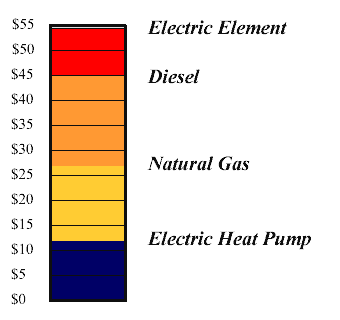How
a Heat Pump works
© Hot Water Heat Pumps Limited

Gas called refrigerant is compressed using a compressor to make it super hot. The Hot gas passes through the heat exchanger in tubes heating the water being passed through it. The expansion valve drops the pressure of the gas turning it into a very cold gas. The fan blows air across the cold gas to warm it up so that the compressor can compress it again. Essentially the heat is taken out of the air leaving cold air being expelled through the evaporator.
Heat Pump Efficiency
Average weekly Pool Heating costs comparison over seven months based on the following tariffs*.
| Electricity | 11.25c / kwhr |
| Gas | 4.5c / kwhr |
| Diesel | 72c / litre |

Pool
Surface Area: 40 Square Meters
*Note:
Tariffs vary in different areas
Epoxy coated evaporator
All "Performance Plus" Heat Pumps have epoxy coated evaporator coils. The "Performance Plus" range is in fact the only Heat Pumps with this special coating. New Zealand is very susceptible to a high concentrations of salt. Especially near the beach. Rotorua has its own problems with high levels of sulphur. No other type of coil has the protection needed to last in these environments.
Coil Fin Material Salt Water Spray Test
|
0
hours ============> 500 hours ============>1000 hours
|
|
|
| Aluminum |
| Alodine Etch Treated Aluminum |
| Copper |
| Epoxy Coated |
For corrosive environments, varieties of lacquered fin stock have been developed as an alternative to the more expensive copper fin stock.
Of the various coatings, for aluminium fin stock, epoxy has emerged as the preferred coating as protection against both chemical and salt laden air corrosion.
The controlled application of epoxy, to the aluminium fin stock, results in a highly corrosion resistant epoxy film of only 4-5 microns.
Although the epoxy coating is extremely thin it provides the remarkable corrosion resistance demonstrated without effecting the heat transfer efficiency of the coil.
The heat transfer efficiency of epoxy coated aluminium fin stock is in fact retained over the long term whereas non epoxy coated coil fins progressively lose efficiency due to fin surface corrosion.
The epoxy coated aluminium fin stock not only survived the aggressive ASTMB287(80) salt fog test virtually unscathed but also survive an equally aggressive MEK solvent test showing a resistance to 100 double rubs.
As standard,
untreated aluminium fin stock is utilised as it has a proven long term
performance under normal operating conditions. Where corrosion protection
is required epoxy coated fin stock is highly recommended.
* The above test was carried out by Western Chemical Teat Laboratory.